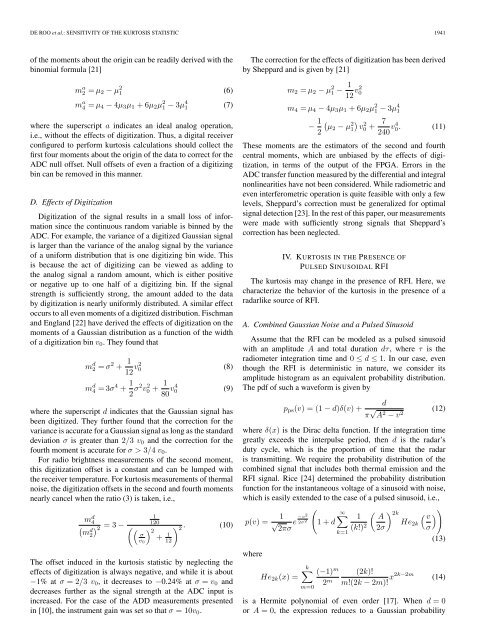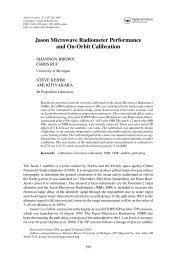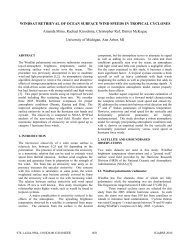Sensitivity of the Kurtosis Statistic as a Detector - Remote Sensing ...
Sensitivity of the Kurtosis Statistic as a Detector - Remote Sensing ...
Sensitivity of the Kurtosis Statistic as a Detector - Remote Sensing ...
Create successful ePaper yourself
Turn your PDF publications into a flip-book with our unique Google optimized e-Paper software.
DE ROO et al.: SENSITIVITY OF THE KURTOSIS STATISTIC 1941<br />
<strong>of</strong> <strong>the</strong> moments about <strong>the</strong> origin can be readily derived with <strong>the</strong><br />
binomial formula [21]<br />
m a 2 = µ 2 − µ 2 1 (6)<br />
m a 4 = µ 4 − 4µ 3 µ 1 +6µ 2 µ 2 1 − 3µ 4 1 (7)<br />
where <strong>the</strong> superscript a indicates an ideal analog operation,<br />
i.e., without <strong>the</strong> effects <strong>of</strong> digitization. Thus, a digital receiver<br />
configured to perform kurtosis calculations should collect <strong>the</strong><br />
first four moments about <strong>the</strong> origin <strong>of</strong> <strong>the</strong> data to correct for <strong>the</strong><br />
ADC null <strong>of</strong>fset. Null <strong>of</strong>fsets <strong>of</strong> even a fraction <strong>of</strong> a digitizing<br />
bin can be removed in this manner.<br />
D. Effects <strong>of</strong> Digitization<br />
Digitization <strong>of</strong> <strong>the</strong> signal results in a small loss <strong>of</strong> information<br />
since <strong>the</strong> continuous random variable is binned by <strong>the</strong><br />
ADC. For example, <strong>the</strong> variance <strong>of</strong> a digitized Gaussian signal<br />
is larger than <strong>the</strong> variance <strong>of</strong> <strong>the</strong> analog signal by <strong>the</strong> variance<br />
<strong>of</strong> a uniform distribution that is one digitizing bin wide. This<br />
is because <strong>the</strong> act <strong>of</strong> digitizing can be viewed <strong>as</strong> adding to<br />
<strong>the</strong> analog signal a random amount, which is ei<strong>the</strong>r positive<br />
or negative up to one half <strong>of</strong> a digitizing bin. If <strong>the</strong> signal<br />
strength is sufficiently strong, <strong>the</strong> amount added to <strong>the</strong> data<br />
by digitization is nearly uniformly distributed. A similar effect<br />
occurs to all even moments <strong>of</strong> a digitized distribution. Fischman<br />
and England [22] have derived <strong>the</strong> effects <strong>of</strong> digitization on <strong>the</strong><br />
moments <strong>of</strong> a Gaussian distribution <strong>as</strong> a function <strong>of</strong> <strong>the</strong> width<br />
<strong>of</strong> a digitization bin v 0 . They found that<br />
m d 2 = σ 2 + 1<br />
12 v2 0 (8)<br />
m d 4 =3σ 4 + 1 2 σ2 v 2 0 + 1 80 v4 0 (9)<br />
where <strong>the</strong> superscript d indicates that <strong>the</strong> Gaussian signal h<strong>as</strong><br />
been digitized. They fur<strong>the</strong>r found that <strong>the</strong> correction for <strong>the</strong><br />
variance is accurate for a Gaussian signal <strong>as</strong> long <strong>as</strong> <strong>the</strong> standard<br />
deviation σ is greater than 2/3 v 0 and <strong>the</strong> correction for <strong>the</strong><br />
fourth moment is accurate for σ>3/4 v 0 .<br />
For radio brightness me<strong>as</strong>urements <strong>of</strong> <strong>the</strong> second moment,<br />
this digitization <strong>of</strong>fset is a constant and can be lumped with<br />
<strong>the</strong> receiver temperature. For kurtosis me<strong>as</strong>urements <strong>of</strong> <strong>the</strong>rmal<br />
noise, <strong>the</strong> digitization <strong>of</strong>fsets in <strong>the</strong> second and fourth moments<br />
nearly cancel when <strong>the</strong> ratio (3) is taken, i.e.,<br />
m d 4<br />
(<br />
m<br />
d<br />
2<br />
) 2<br />
=3−<br />
1<br />
120<br />
( (<br />
σ<br />
v 0<br />
) 2<br />
+<br />
1<br />
12<br />
) 2<br />
. (10)<br />
The <strong>of</strong>fset induced in <strong>the</strong> kurtosis statistic by neglecting <strong>the</strong><br />
effects <strong>of</strong> digitization is always negative, and while it is about<br />
−1% at σ =2/3 v 0 , it decre<strong>as</strong>es to −0.24% at σ = v 0 and<br />
decre<strong>as</strong>es fur<strong>the</strong>r <strong>as</strong> <strong>the</strong> signal strength at <strong>the</strong> ADC input is<br />
incre<strong>as</strong>ed. For <strong>the</strong> c<strong>as</strong>e <strong>of</strong> <strong>the</strong> ADD me<strong>as</strong>urements presented<br />
in [10], <strong>the</strong> instrument gain w<strong>as</strong> set so that σ =10v 0 .<br />
The correction for <strong>the</strong> effects <strong>of</strong> digitization h<strong>as</strong> been derived<br />
by Sheppard and is given by [21]<br />
m 2 = µ 2 − µ 2 1 − 1<br />
12 v2 0<br />
m 4 = µ 4 − 4µ 3 µ 1 +6µ 2 µ 2 1 − 3µ 4 1<br />
− 1 (<br />
µ2 − µ 2<br />
2<br />
1)<br />
v<br />
2<br />
0 + 7<br />
240 v4 0. (11)<br />
These moments are <strong>the</strong> estimators <strong>of</strong> <strong>the</strong> second and fourth<br />
central moments, which are unbi<strong>as</strong>ed by <strong>the</strong> effects <strong>of</strong> digitization,<br />
in terms <strong>of</strong> <strong>the</strong> output <strong>of</strong> <strong>the</strong> FPGA. Errors in <strong>the</strong><br />
ADC transfer function me<strong>as</strong>ured by <strong>the</strong> differential and integral<br />
nonlinearities have not been considered. While radiometric and<br />
even interferometric operation is quite fe<strong>as</strong>ible with only a few<br />
levels, Sheppard’s correction must be generalized for optimal<br />
signal detection [23]. In <strong>the</strong> rest <strong>of</strong> this paper, our me<strong>as</strong>urements<br />
were made with sufficiently strong signals that Sheppard’s<br />
correction h<strong>as</strong> been neglected.<br />
IV. KURTOSIS IN THE PRESENCE OF<br />
PULSED SINUSOIDAL RFI<br />
The kurtosis may change in <strong>the</strong> presence <strong>of</strong> RFI. Here, we<br />
characterize <strong>the</strong> behavior <strong>of</strong> <strong>the</strong> kurtosis in <strong>the</strong> presence <strong>of</strong> a<br />
radarlike source <strong>of</strong> RFI.<br />
A. Combined Gaussian Noise and a Pulsed Sinusoid<br />
Assume that <strong>the</strong> RFI can be modeled <strong>as</strong> a pulsed sinusoid<br />
with an amplitude A and total duration dτ, where τ is <strong>the</strong><br />
radiometer integration time and 0 ≤ d ≤ 1. In our c<strong>as</strong>e, even<br />
though <strong>the</strong> RFI is deterministic in nature, we consider its<br />
amplitude histogram <strong>as</strong> an equivalent probability distribution.<br />
The pdf <strong>of</strong> such a waveform is given by<br />
d<br />
p ps (v) =(1− d)δ(v)+<br />
π √ (12)<br />
A 2 − v 2<br />
where δ(x) is <strong>the</strong> Dirac delta function. If <strong>the</strong> integration time<br />
greatly exceeds <strong>the</strong> interpulse period, <strong>the</strong>n d is <strong>the</strong> radar’s<br />
duty cycle, which is <strong>the</strong> proportion <strong>of</strong> time that <strong>the</strong> radar<br />
is transmitting. We require <strong>the</strong> probability distribution <strong>of</strong> <strong>the</strong><br />
combined signal that includes both <strong>the</strong>rmal emission and <strong>the</strong><br />
RFI signal. Rice [24] determined <strong>the</strong> probability distribution<br />
function for <strong>the</strong> instantaneous voltage <strong>of</strong> a sinusoid with noise,<br />
which is e<strong>as</strong>ily extended to <strong>the</strong> c<strong>as</strong>e <strong>of</strong> a pulsed sinusoid, i.e.,<br />
p(v) = 1 √<br />
2πσ<br />
e −v2<br />
2σ 2 (1+d<br />
where<br />
He 2k (x) =<br />
k∑<br />
m=0<br />
∞∑<br />
( ) 2k<br />
1 A<br />
( v<br />
) )<br />
(k!) 2 He 2k<br />
2σ σ<br />
(13)<br />
k=1<br />
(−1) m<br />
2 m (2k)!<br />
m!(2k − 2m)! x2k−2m (14)<br />
is a Hermite polynomial <strong>of</strong> even order [17]. When d =0<br />
or A =0, <strong>the</strong> expression reduces to a Gaussian probability





